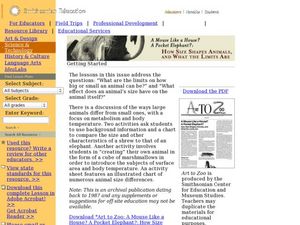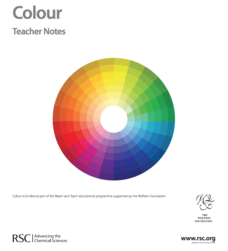Curated OER
How Size Shapes Animals
Students investigate how size affects large and small animals differently. In this animal lesson plan, students determine how size affects different animals by constructing their own animal out of marshmallows. Once students create...
Curated OER
LEARN NOT TO BURN!
Students observe the effect of different filter thickness on ultraviolet radiation and discover that ultraviolet radiation is necessary for the production and destruction of ozone.
Curated OER
Jenny's Science Wordsearch
In this biology worksheet, students identify and locate various vocabulary terms related to the science of biology and anatomy. There are 10 biology terms located in the word search.
Curated OER
It's a bright and beautiful day...Protect Yourself!
Students investigate the cause and effect of skin cancer. They complete worksheets, view presentations and discuss the various types of ultraviolet rays and their impact on human health.
Curated OER
Integumentary System
In this integumentary system worksheet, 9th graders list the two major layers of the skin and name the type of tissue composing each layer. Then they describe the structure and function of the hypodermis. Students also list three types...
Reach Out!
Paper Clip Sailing
Young scholars explain that some things can float on top of water because of what we call "surface tension." They see that if something happens to disturb these water molecules from tugging on each other, the skin-like surface breaks up.
Curated OER
Activities of the Immune System (Activity 1)
High schoolers cut an apple in half and cover half with plastic wrap. They place drops of liquid on each half and discover how our skin protects us. They answer discussion questions to end the lesson.
Curated OER
Protection, Support, and Locomotion
In this human body worksheet, students will review 5 terms associated with the skin by filling in the blank. Then students will read 14 statements about the human skeleton and muscles and determine if its true or false.
Curated OER
Mapping the Homunculus
Students determine the relative number of nerve endings located in the skin. By calculating the reciprocal of these measurements, students have the appropriate data for predicting the relative size of the homunculus found on the cerebral...
Curated OER
Frogs and Camouflage
Students view a variety of pictures of frogs and discuss camouflage and habitat adaptation. Students look at color, skin texture, shape, size, eyes, and surroundings as well as the need for the camouflage. Students then design a frog...
Curated OER
Cell Growth and Division
In this biology worksheet, 9th graders label the diagrams with the appropriate phase of mitosis illustrated. Then they explain why skin cell undergo mitosis continuously. Students also explain why mitosis is a form of asexual reproduction.
Curated OER
The Excretory System
In this excretory system instructional activity, students describe the functions that the organs of the urinary system perform and what happens when the kidneys do not work properly. Students also name the excretory organs of the body...
Curated OER
The Cleaning Station
Students study cleaning stations. In this science lesson, students make a painting of a fish known as cleaners which take dead skin off of other fish.
Intel
Cell-to-Cell
The third in a series of 10 STEM project-based lessons focuses on cells types, functions, and physiology. Through research, discussions, writings, and presentations, groups learn about the difference between plant and animal cells, the...
Royal Society of Chemistry
Colour—Gifted and Talented Chemistry
Add a splash of color to your chemistry class! Science scholars discover the principles behind color through a wide variety of hands-on activities. Lessons include dyes, chromatography, and flame tests.
Curated OER
Using Microscopes
Students do an experiment using a microscope. In this activity, about cells, students examine different slides using a microscope. Students look at an onion skin, cheek cells, and potato cells. In each of these, students find cell walls,...
Curated OER
Fossils and Dinosaurs
Students explore fossils and dinosaurs. In this science lesson, students discuss how fossils are created. Students draw muscles and skin on a stegosaurus.
Education Outside
Natural Dye Tie-Dye
Up-cycle, or reprocess waste materials, into colorful tie-dye clothing or banners with an activity that uses fruits and vegetable juices as dye sources.
Curated OER
Dog Salmon Lesson Three
Middle schoolers observe patterns and scale sizes on the salmon skin. They explore the tanning of salmon skills and practice the Athabascan terms for the salmon parts. They make salmon skin prints.
Curated OER
Habitats
Students are introduced to various animals and their habitats. In groups, they must determine which animal skin matches the correct animal and identify the texture. They discuss the reason for the texture and width of the skin to end...
Curated OER
Physical Science: Dying for a Tan?
Pupils assess how much harm UV radiation can have on your skin and how much protection is provided by sunblock, sunglasses and clothing. They experiment with UV index numbers and the amount of exposure risk of skin damage for any given day.
Curated OER
Learning Activities: What Color Am I?
Young scholars identify various species of anurans by their skin coloration. They describe how coloration contributes to survival.
Curated OER
Butterflies
Students view the four stages in the growth of a butterfly. They are told that once a caterpillar hatches, its skin can't grow fast enough to make room for all its growth. Students are asked if they have seen a caterpillar? They are...
Curated OER
Variation
Young scholars explore how variation is affected by the environment. They explain ways in which variation can be altered by the environment. Students investigate the effects of sunlight on skin.
Other popular searches
- Skinny Bones
- Human Biology Skin
- Skin Cancer
- B.f. Skinner
- Healthy Skin
- Skinny Bones Book Review
- Skin Care
- The Skin
- Buffalo Skins
- Skin Anatomy
- Skin Safety
- Skinny Bones Novel Unit

























